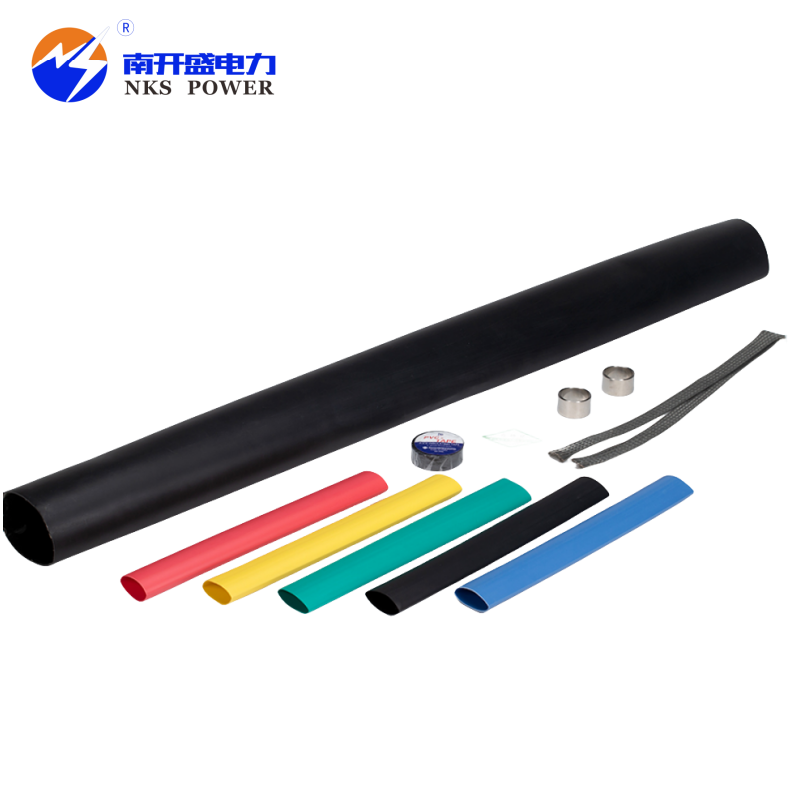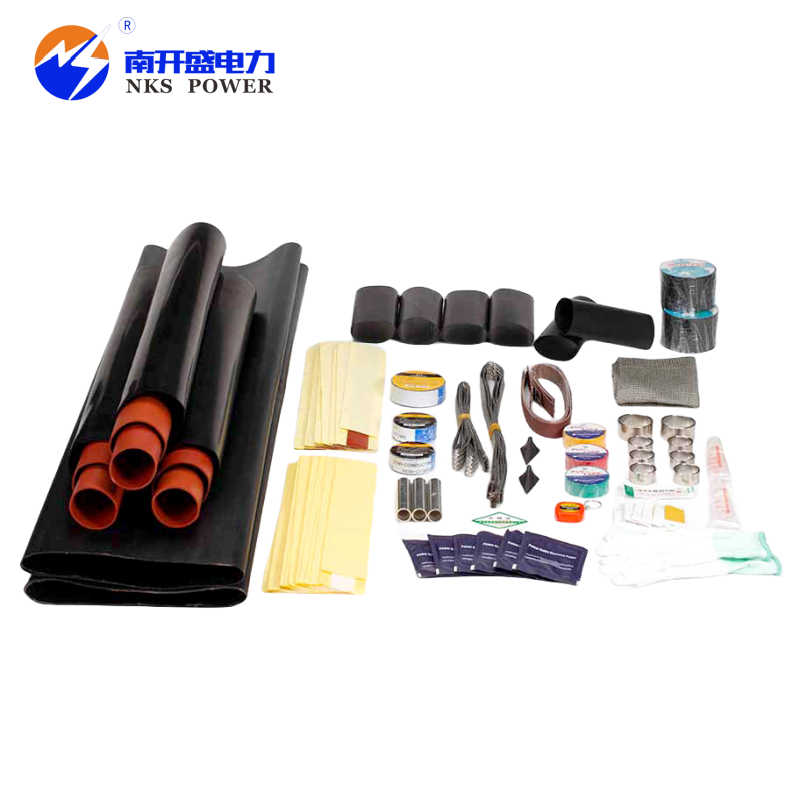I. Introduction
Heat shrink cable joints play a vital role in making safe and harmless links for power supply systems, factory setups, and phone lines. This gives them a major push toward safety from weather conditions while keeping the long-term dependability of any electrical setup.
As applications increase through utilities, renewable energy, and urban development, these joints are available in a wide variety for different voltage ratings and environmental conditions. Specialists may derive validated solutions customized to individual operating requirements to ensure optimum performance and durability.
II. Classification by Voltage Rating
1. Low-Voltage Heat Shrink Cable Joints (Up to 1kV)
Low-voltage heat shrink cable joints are common for residential and commercial electrical installations since they offer a safe method of connecting cables, which is easy to perform and not expensive. They are made from radiation-crosslinked polyolefin material, which provides high insulation properties but remains soft enough to allow an easy installation process.
With a 2:1 to 3:1 shrinkage ratio, they form tight seals over a wide range of cable diameters. Installation can be done easily with the use of common tools such as propane torches or hot air guns and there is no need for special training. Typical applications are building wire, panel connections, temporary power set up, and cable repair.

2. Medium-Voltage Heat Shrink Cable Joints (1kV to 36kV)
Medium-voltage applications demand more sophisticated heat shrink cable joints capable of withstanding higher electrical stresses and challenging environmental conditions.
The 15kV heat shrink cable joint is an answer for industrial plants and municipal distribution networks that fulfills the best. Multi-layers of semi-conductive and insulating materials coordinate together, enabling control over the electrical field distribution inside. Among technical advantages, it can be used for both types of cables: PILC and XLPE, has integrated moisture barriers when installed underground, and performs well in all cold weather conditions up to -40°C.
24kV cable joints are designed out of heat shrink for extremely tough applications in the medium voltage range from high-performance polymers with increased levels of dielectric strength and tracking resistance. Such high-performance joints may be provided with metallic screening layers to improve electromagnetic compatibility in highly sensitive environments thus, renewable energy systems, industrial facilities, or urban power networks where reliability has to be maintained. The robust construction gives a guarantee of long-term durability with simple installation by means of controlled heating processes.
35kV joints are the very latest technology in medium voltage technology with inside advanced hybrid stress control systems coupled to the heat/cold-shrink design for application in critical power transmission. Such joints incorporate innovative corona suppression technology and improved chemical resistance against aggressive environments where industrial oils as well as thermal cycling can be found. Tested intensively regarding reliability under harsh conditions, offering the best electrical field control and long life.
III. Specialized Application Variants
1. Transition Joints for Mixed Cable Types
Transition joints therefore give very important solutions in the connection of dissimilar cable technologies, that is, PILC to XLPE or EPR to MI cables. Specialized heat shrink cable joints contain specially designed interface components ensuring smooth electrical performance between different insulation systems. The design considerations for such products include dielectric property matching, thermal expansion characteristic management, and mechanical compatibility provisioning between different cable constructions.
2. Submarine and Offshore Rated Joints
Environmental conditions at sea place particular demands on penetration by water and mechanical strength. Special submarine-rated heat shrink cable joints use multi-layer moisture barriers, which will not permit the entrance of water even under high hydrostatic pressure. The typical construction provides for armor compatibility when used in a direct burial application besides increased resistance to seawater corrosion.
3. Fire-Rated and Safety Critical Joints
In the applications of tunnel, high-rise building, and nuclear installations, fire-performance heat shrink cable joints that can respond to the highest degree of safety are used. The special product lines apply halogen-free material formulations with reduced toxicity to the smoke being emitted during burning. The designs provide circuit integrity under fire conditions, allowing systems critical to safety to continue operating.

IV. Material Technology and Performance Considerations
1. Advanced Polymer Formulations
Cross-linked polyolefin compounds form the base materials resulting from highly engineered polymers that modern heat shrink cable joints take advantage of since there has been major progress in polymer science. These particular class of engineered polymers display extremely high levels of thermal stability over and above exhibiting very good mechanical properties retained within large temperature ranges. Manufacturers further process these materials by introducing special additive packages which carry properties for enhanced performance characteristics specific to applications.
2. Adhesive System Technology
(1) Bonding Performance
The adhesive systems in modern joints form permanent, molecular-level bonds with cable surfaces. These high-performance adhesives maintain flexibility to accommodate thermal expansion and contraction during load cycles, preventing delamination or seal failure over time.
(2) Moisture Protection
Advanced adhesive formulations create continuous, impermeable seals that effectively block moisture migration pathways. The viscoelastic properties of these adhesives allow them to flow and fill microscopic surface imperfections during installation, ensuring complete environmental protection.
(3) Installation Considerations
Proper adhesive activation requires precise temperature control during installation. The quality of adhesive flow directly correlates with long-term performance, affecting the joint's resistance to water treeing, partial discharge, and other degradation mechanisms.
3. Mechanical Protection Systems
(1) Impact Resistance
Many joint designs incorporate multi-layer outer sleeves with engineered polymers that provide exceptional impact resistance. These protective layers shield the underlying insulation from mechanical damage during installation and throughout the service life.
(2) System Integration
The mechanical protective components act in conjunction with the basic insulation system, ensuring total protection against physical, chemical, and environmental conditions while sustaining the best electrical performance. Continuous advancements in these material technologies guarantee that heat shrink cable joints will fulfill progressively stringent performance standards in a wide range of applications.
V. Installation Best Practices
1. Pre-Installation Preparation
(1) Surface Preparation
Installation starts with detailed surface preparation aimed at achieving the best joint performance. All cable surfaces must be cleaned by the technicians using solvents and abrasives, which will effectively remove any dirt and oils as well as oxidation layers where the adhesive will stick. This cleaning should be followed by surface roughening that is meticulously carried out with the use of appropriate tools to develop the right profile for adhesive bonding while not inflicting harm on underlying material.
(2) Cable Termination
Remove the Insulation accurately according to drawings. Remove or treat the Inner and Outer semiconductors as per the type of cable. Ensure measurement for exposure of conductor. Ensure during preparation work of multi-core cables that phase identification is maintained properly.
2. Heat Application Process
(1) Temperature Control
Temperature control in the heat application phase is very critical because proper recovery of the material has to be achieved without causing any thermal damage. Technicians should be using calibrated heating equipment, and in most cases, temperature distribution should be continuously monitored so that values can be maintained within the specified range, Particular attention should be provided to avoid any localized overheating since this can compromise not only material properties but also joint integrity.
(2) Shrinkage Technique
Proper shrinkage methodology involves a systematic heating approach that ensures complete material recovery. Technicians should begin heating at the center of the joint and progress outward toward the ends while maintaining uniform circumferential heat distribution. The heating speed must be carefully controlled to allow sufficient time for complete adhesive flow and proper bonding.
VI. Conclusion
The continuing development of heat shrink cable joint technology answers the complex requirements of contemporary power systems for everything from rudimentary low-voltage use to high-end high-voltage applications. These components continue to play a very critical role in the worldwide electrical infrastructure and it does not matter what the voltage class or environmental condition is, there is always a solution for all of them. Selection depends on several technical requirements, installation considerations, and long-term performance. Next-generation developments include intelligent materials with monitoring capabilities as well as sustainable solutions that work hand-in-hand with energy from renewable resources and smart grids. This industry keeps restructuring; thus, heat shrink technology remains at its best possible state-of-the-art cable jointing solution toward modern power systems.
















